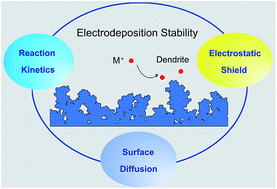Cationic shield mediated electrodeposition stability in metal electrodes†
Abstract
High-energy-density rechargeable batteries, comprising metal electrodes, such as lithium metal anodes, are desirable to meet the ever-increasing demand for energy storage. Metallic dendrite formation, however, poses a critical challenge leading to inferior cycling performance and safety concerns. Here, we present a comprehensive analysis of the electrochemical–transport complexation underlying the cationic shield mechanism, attributed to the presence of additive cations which holds promise toward mitigating dendritic electrodeposition. It is found that the dendrite growth is significantly alleviated by the electrostatic shield in the reaction-kinetics-limited regime, while this effect relies on the concentration of additive cations physically adsorbed to dendrite tips. Furthermore, the competition between the reaction rate and transport rate of additive cations plays a pivotal role in dendrite suppression. In the transport-limited regime, the cationic shield mechanism assists in relatively uniform growth of the otherwise dendritic features. This study provides a comprehensive understanding of the cationic shield mechanism and demonstrates its potential toward stable electrodeposition.



 Please wait while we load your content...
Please wait while we load your content...